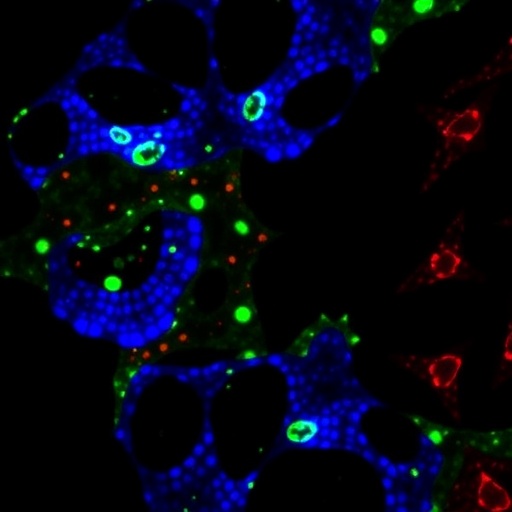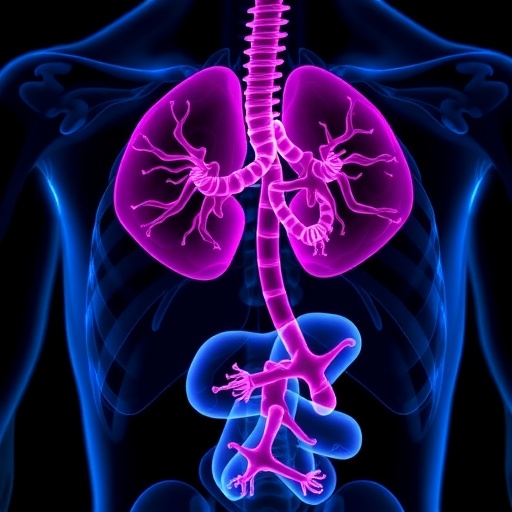In a groundbreaking study that could redefine therapeutic strategies against osteosarcoma, researchers have unveiled the molecular intricacies by which Bone Morphogenetic Protein 9 (BMP-9) modulates immune evasion in cancer cells. The study, conducted by Zhang, Ge, and Xu, demonstrates the pivotal role of BMP-9 in upregulating the immune checkpoint molecule PD-L1 through the transcription factor FOXO1, shedding new light on the complex signaling pathways that allow osteosarcoma to circumvent immune surveillance.
Osteosarcoma, a malignant bone tumor prevalent in adolescents and young adults, presents a formidable challenge due to its aggressive nature and limited treatment options. Traditional therapies, including surgery, chemotherapy, and radiotherapy, often fail to prevent metastasis, underscoring the urgent need for novel molecular targets. Immune checkpoint inhibitors have recently emerged as promising agents in cancer therapy by reactivating the immune system to attack tumor cells, largely by blocking the PD-1/PD-L1 axis. However, the regulation of PD-L1 expression in osteosarcoma remains incompletely understood, and this new insight into BMP-9’s role could be a game changer.
BMP-9 is a member of the transforming growth factor-beta (TGF-β) superfamily, known for its involvement in bone formation and repair. While its role in bone physiology has been extensively studied, this latest research pushes the envelope by revealing BMP-9’s function within the tumor microenvironment, specifically in modulating immune escape mechanisms. The research team illuminated the pathway leading from BMP-9 stimulation to the enhancement of PD-L1 expression, identifying FOXO1 as a critical transcriptional activator in the process.
FOXO1, a forkhead box transcription factor, has been widely recognized for its involvement in cell survival, metabolism, and oxidative stress responses. Zhang and colleagues’ data convincingly show that BMP-9 activates FOXO1, which in turn binds to the promoter region of the PD-L1 gene, driving its transcription and subsequent protein expression on the osteosarcoma cell surface. This molecular cascade implicates FOXO1 as a central node linking extracellular signaling by BMP-9 to the immune checkpoint expression machinery.
The implications of these findings are profound. By enhancing PD-L1, osteosarcoma cells effectively dampen the activation and cytotoxic responses of T cells, enabling tumor progression and resistance to immune-mediated destruction. The elucidation of BMP-9’s role in this mechanism offers a dual avenue for therapeutic intervention: targeting BMP-9 activity or its downstream mediator FOXO1 could suppress PD-L1 expression and potentially enhance the efficacy of immune checkpoint blockade therapies.
Methodologically, the researchers employed a combination of in vitro osteosarcoma cell culture models, RNA interference, chromatin immunoprecipitation assays, and flow cytometry analyses to dissect the BMP-9/FOXO1/PD-L1 axis. Their robust experimental design ensured that the observations were not merely correlative but indicative of a causal regulatory relationship. Such mechanistic clarity provides a strong foundation for future translational research aimed at clinical application.
The study also contextualizes its findings within the broader landscape of tumor immunology and the role of TGF-β family members in immune regulation. While some BMPs have been noted to exert anti-tumor effects, BMP-9’s upregulation of PD-L1 introduces a paradox, illustrating the complexity and context-dependency of signaling molecules in cancer biology. This nuanced understanding encourages a reevaluation of BMP signaling as a potential therapeutic target, cautioning against generalized assumptions about its tumorigenic or tumor-suppressive functions.
Cancer immunotherapy has revolutionized oncology, but not all patients benefit equally from checkpoint inhibitors. The mechanistic insights into BMP-9’s influence on PD-L1 add an important dimension to the understanding of resistance mechanisms. This revelation could guide personalized treatment strategies, wherein patients with elevated BMP-9 signaling might receive combination therapies incorporating BMP-9 pathway inhibitors alongside immune checkpoint blockade to overcome therapeutic resistance.
Furthermore, the identification of FOXO1 as a transcriptional control point suggests new biomarkers for assessing prognosis and therapeutic response. Measuring FOXO1 and BMP-9 levels could inform clinicians about the tumor’s immune evasive potential and guide the timing and selection of immunotherapies. Such predictive biomarkers are critical for optimizing treatment efficacy and minimizing unnecessary exposure to costly and potentially toxic agents.
The molecular dialogue uncovered by Zhang et al. also invites investigation into BMP-9’s role in other malignancies beyond osteosarcoma, given the conserved nature of PD-L1 regulation across cancers. Exploring whether this pathway operates similarly in other tumor types could broaden the impact of these findings and pave the way for multi-cancer therapeutic approaches targeting BMP-9 or FOXO1.
Notably, the study illustrates the value of dissecting intracellular signaling networks to uncover vulnerabilities in cancer cells that can be therapeutically exploited. It exemplifies the intersection of developmental biology, immunology, and oncology, highlighting the multifaceted nature of cancer and the necessity of interdisciplinary approaches to advance the field.
While this research marks significant progress, it also raises new questions. For example, the precise upstream signals that modulate BMP-9 expression within the tumor microenvironment, and how these interact with other pro- or anti-inflammatory factors, remain to be elucidated. Additionally, in vivo studies and clinical trials will be essential to validate the safety and efficacy of targeting this newly delineated pathway.
Moreover, the balance between inhibiting BMP-9’s tumor-promoting effects and preserving its physiological functions in bone and vascular biology must be carefully considered. Drug development efforts will need to achieve specificity to minimize off-target effects that could impair bone health or other essential bodily processes.
In conclusion, the discovery that BMP-9 promotes PD-L1 expression through FOXO1 in osteosarcoma cells represents a substantial leap forward in understanding the molecular underpinnings of immune evasion in this aggressive cancer. It opens promising avenues for novel therapeutic strategies combining immunomodulation with pathway-specific interventions, holding the potential to improve outcomes for patients afflicted with osteosarcoma.
This work underscores the importance of continued basic and translational research to decode cancer’s sophisticated defense mechanisms. As the oncology community strives to transform deadly tumors into manageable diseases, insights like those provided by Zhang, Ge, and Xu offer both hope and a roadmap toward more effective, personalized treatments.
Subject of Research: The molecular mechanism by which BMP-9 promotes PD-L1 expression in osteosarcoma cells via the transcription factor FOXO1.
Article Title: BMP-9 promotes the expression of PD-L1 in osteosarcoma cells through FOXO1.
Article References:
Zhang, W., Ge, Y. & Xu, X. BMP-9 promotes the expression of PD-L1 in osteosarcoma cells through FOXO1. Med Oncol 42, 535 (2025). https://doi.org/10.1007/s12032-025-03097-2
Image Credits: AI Generated
Tags: BMP-9 and osteosarcoma relationshipbone tumor immunologychallenges in osteosarcoma treatmentFOXO1 transcription factor roleImmune checkpoint inhibitors in cancer therapyimmune evasion mechanisms in tumorsmolecular targets for cancer therapynovel therapeutic strategies for osteosarcomaPD-L1 regulation in cancersignaling pathways in osteosarcomaTGF-β superfamily functionsunderstanding PD-1/PD-L1 axis






